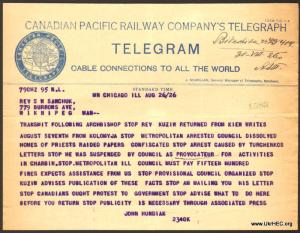Museum artifacts and archival documents can be voices from the past that tell us about life, beliefs, rituals, and events, provided that one knows how to "read" them. This is particularly important for archival items, which sometimes can't be fully understood without knowing the context in which they were generated. A researcher must carefully think about the "what?", "where?", "when?", and "why?" behind each item, and how it relates to the other items in the collection.
For example, the basic "what?", "where?", and "when?" of the item shown here are seemingly obvious: it's a telegram (the 19th and 20th century equivalent of a text message) sent from John Hundiak in Chicago to Rev. S. W. Sawchuk in Winnipeg on August 26, 1926 describing some momentous-sounding events in Ukraine. But that does not really answer the real question of "what is this telegram about?" or "why was it sent?". For that, we need to know more about its context, as well as some early 20th century Ukrainian religious history.
This telegram comes from a collection of records from the Chancery of the Ukrainian Orthodox eparchy led by Archbishop Ioann (Teodorovych), and its sender and recipient both played significant administrative functions within that eparchy. Fr. John Hundiak would by the 1980s become an archbishop in his own right, taking on the monastic name of Mark. Fr. Semen (Samuel) Sawchuk was Abp. Ioann's administrator for Canada, and would go on to play a huge role in the life of the Ukrainian Orthodox Church in Canada for decades to come.
So, the "archbishop" referred to in the first line of the telegram is obviously Abp. Ioann. Although his chancery was in Chicago, he must have been traveling through Canada in August of 1926, and Fr. Hundiak decided that the letter he had just received from Ukraine was sufficiently urgent and important that it warranted a long telegram to Fr. Sawchuk, who then passed it on to Abp. Ioann.
Apb. Ioann had been ordained by Metropolitan Vasyl' (Lypkivs'kyi) in Kyiv in 1924, not long after Metr. Vasyl' himself had been ordained in an irregular fashion by the Council ("Sobor") of the newly-proclaimed Ukrainian Autocephalous Orthodox Church (UAOC). While the UAOC had been tolerated to some degree under Lenin, the Stalin regime began to consider it a serious threat, combining as it did two of the things most hated by that totalitarian government: nationalism and religion. The events described in this telegram represent one of the first attacks by the Soviet government against the UAOC and its leader. These attacks would become more and more viciously repressive during the coming decade, ultimately resulting in the arrest, exile, and killing of many of its bishops and clergy, including Metr. Vasyl'.
There are two remaining mysteries: who was Rev. Kuziw, and who was this "provocateur" Turchenko living in "Charbin" (i.e. the Chinese city of Harbin)? We don't quite know yet. We can, however, surmise that the reason Fr. Kuziw traveled from Kyiv to Kolomyia to send his letter was that Kolomyia was outside the reach of Soviet censors (being then part of the inter-war Polish Republic). The activities of Turchenko that would have so riled the Soviet authorities are still somewhat mysterious, although the Chancery Records which contain this telegram also have letters written by Rev. Turchenko in Harbin addressed to Abp. Ioann which will allow future researchers to learn more about this man and his activities.




